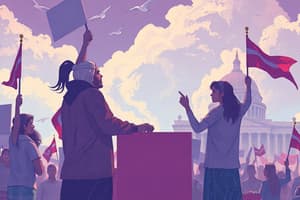Podcast
Questions and Answers
Which amendment prohibits the denial of voting rights based on gender?
Which amendment prohibits the denial of voting rights based on gender?
- 24th Amendment
- 19th Amendment (correct)
- 15th Amendment
- 17th Amendment
What is the primary focus of the 23rd Amendment?
What is the primary focus of the 23rd Amendment?
- Lowering the voting age to 18
- Abolishing poll taxes in federal elections
- Ensuring direct election of senators
- Granting Washington D.C. residents the right to vote in presidential elections (correct)
Which amendment specifically addresses and eliminates poll taxes in federal elections?
Which amendment specifically addresses and eliminates poll taxes in federal elections?
- 24th Amendment (correct)
- 19th Amendment
- 26th Amendment
- 15th Amendment
A voter consistently supports candidates from the Republican party for all positions, from local to national elections. Which voting behavior model does this exemplify?
A voter consistently supports candidates from the Republican party for all positions, from local to national elections. Which voting behavior model does this exemplify?
A citizen assesses the current economic conditions and votes against the incumbent president because they believe the economy has worsened under their leadership. Which voting behavior model are they using?
A citizen assesses the current economic conditions and votes against the incumbent president because they believe the economy has worsened under their leadership. Which voting behavior model are they using?
Which of the following scenarios exemplifies prospective voting?
Which of the following scenarios exemplifies prospective voting?
Which of the following scenarios represents a structural barrier to voting?
Which of the following scenarios represents a structural barrier to voting?
Why do U.S. presidential elections typically have higher voter turnout compared to midterm elections?
Why do U.S. presidential elections typically have higher voter turnout compared to midterm elections?
How does political efficacy typically influence voter turnout?
How does political efficacy typically influence voter turnout?
How does age correlate with voter turnout in the United States?
How does age correlate with voter turnout in the United States?
Which of the following lists represents three key factors that commonly influence voter choice?
Which of the following lists represents three key factors that commonly influence voter choice?
How might religious beliefs influence a citizen's voting decisions?
How might religious beliefs influence a citizen's voting decisions?
Which political party do women predominantly tend to support, and what is a possible explanation for this trend?
Which political party do women predominantly tend to support, and what is a possible explanation for this trend?
Which political party do Black and Latino voters tend to support, and why?
Which political party do Black and Latino voters tend to support, and why?
What is the general voting pattern of Asian-American voters in the United States?
What is the general voting pattern of Asian-American voters in the United States?
What is the primary function of linkage institutions in a political system?
What is the primary function of linkage institutions in a political system?
Which of the following is the MOST accurate description of a political party platform?
Which of the following is the MOST accurate description of a political party platform?
How frequently are party platforms typically developed and revised, and why?
How frequently are party platforms typically developed and revised, and why?
Which of the following best describes the electorate?
Which of the following best describes the electorate?
What defines public policy?
What defines public policy?
Flashcards
15th Amendment
15th Amendment
Prohibits denying citizens the right to vote based on race or color.
17th Amendment
17th Amendment
Establishes direct election of senators by the people of each state.
19th Amendment
19th Amendment
Guarantees women the right to vote.
23rd Amendment
23rd Amendment
Signup and view all the flashcards
24th Amendment
24th Amendment
Signup and view all the flashcards
26th Amendment
26th Amendment
Signup and view all the flashcards
Rational choice voting
Rational choice voting
Signup and view all the flashcards
Retrospective voting
Retrospective voting
Signup and view all the flashcards
Prospective voting
Prospective voting
Signup and view all the flashcards
Party-line voting
Party-line voting
Signup and view all the flashcards
Linkage institution
Linkage institution
Signup and view all the flashcards
Party platform
Party platform
Signup and view all the flashcards
Study Notes
- The 15th Amendment prohibits voting discrimination based on race or color.
- The 17th Amendment allows each state to elect two senators.
- The 19th Amendment prohibits voting discrimination based on gender.
- The 23rd Amendment grants residents of Washington, D.C. the right to vote in presidential elections.
- The 24th Amendment abolishes poll taxes in federal elections.
- The 26th Amendment lowered the voting age from 21 to 18.
Political Models of Voting Behavior
- Rational choice voting is voting based on what is perceived to be in the citizen’s individual interest.
- Retrospective voting is voting based on the recent past performance of the party or candidate in power.
- Prospective voting is voting based on predictions of how a party or candidate will perform in the future.
- Party-line voting involves supporting candidates from one political party for all public offices at the same level of government.
Structural Barriers
- Voter registration and homelessness are examples of structural barriers to voting.
- Midterm elections are general elections held near the midpoint of a president's four-year term.
- Voter turnout is generally highest in presidential elections, potentially due to international interest.
- Political efficacy is a citizen's feeling about their ability to influence the outcome of a vote.
- Older individuals are more likely to vote, due to a desire to maintain stability in their lives.
Factors Influencing Voter Choice
- Party identification and ideological orientation influence voter choice.
- Contemporary political issues influence voter choice.
- Religious beliefs or affiliation influence voter choice.
- Religious beliefs may affect voting if a religion's tenets contradict a candidate's stance on issues like abortion.
- Women tend to vote Democratic because this party promotes women's opportunities in jobs, etc.
- Black and Hispanic voters tend to vote Democratic because the party addresses their needs and wants.
- European-American voting patterns vary due to factors like ancestral origins, education, and social issues.
- Asian-American voting patterns are split, around 50% for each party.
Linkage Institutions
- Linkage institutions connect individuals' preferences to policymakers.
- Linkage institutions connect people to the government.
- Media are often used to voice opinions.
- Common sources of political information are TV and media, including social media.
- Political parties articulate party platforms/goals, recruit candidates, and manage campaigns, including fundraising and media strategies.
- The electorate consists of all eligible and registered voters. (U.S. citizens, 18 years or older and not disqualified by law)
- Party campaigns coordinate candidate-centered activities.
- A party platform is developed every 4 years and articulated throughout the campaigns.
Public Policy
- Public policy consists of laws implemented to address public issues and achieve societal objectives.
- Obamacare is an example of public policy, aimed at health insurance reform by making it more affordable
Studying That Suits You
Use AI to generate personalized quizzes and flashcards to suit your learning preferences.




